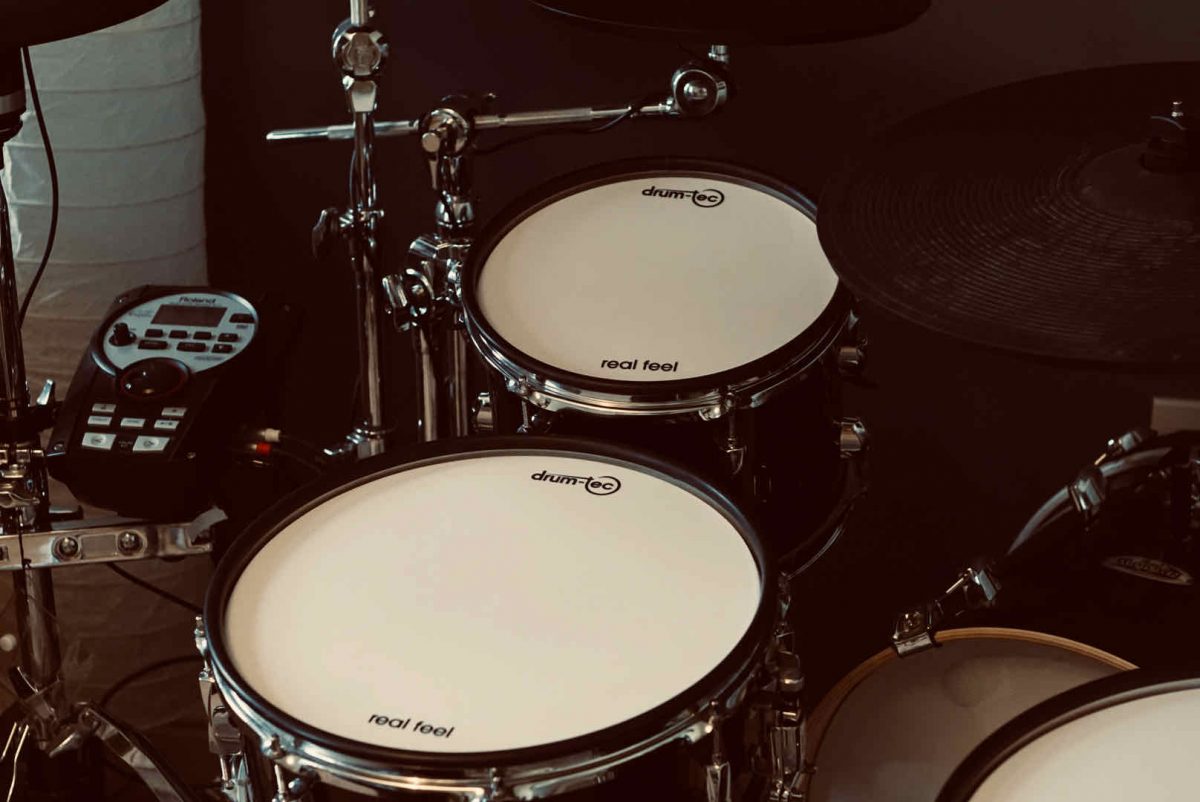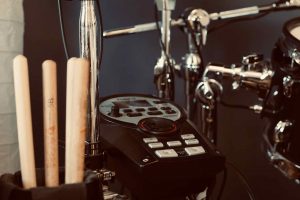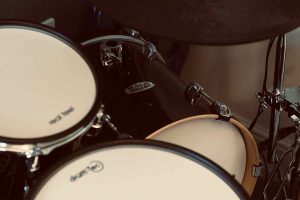If you’re new to electronic drums, whether as a complete beginner, or a seasoned acoustic drum player looking for a quieter way to practice, you may wonder how exactly an electronic drum kit works. Below, we’ll take a look at the key components of how an electronic drum kit turns a drum stroke into an audible sound.
How does an electronic drum set work?
The way an electronic drum kit works can be broken down into a number of basic steps:
- Playing the drum pad triggers a piezo sensor
- The Piezo turns the drum stroke into an electronic signal that’s sent to the drum module
- The drum module converts the electronic signal into a drum sound to closely mimic the way the drum was originally played
- The drum module plays the resulting drum sound to the headphone or speaker output
- Steps 1-4 repeat for every drum stroke in under 10 milliseconds
Read on as we get into the details of these steps and learn a bit more about the theory of how it all works.
Components of an electronic drum kit
There are three main components of an electronic drum kit – the drum module (or drum brain), the drum pads (for the snare drum, bass drum, and tom drums), and the cymbal pads (crash, hi-hat and ride). All three types of components are then connected together via a set of cables – that is until wireless drums become mainstream.
How drum modules work
The drum module, also known as drum brain, is literally the brains of the operation. The module’s job is to take the trigger inputs from every pad, interpret the timing and velocity of every hit, convert this into appropriate drum and cymbal sounds matching your performance, and then play this back.
All this has to happen in under 10 milliseconds of latency so as not to introduce a noticeable delay between hitting the drum pad and hearing the sound. While this doesn’t sound like much, any amount of latency over this amount would make it almost impossible to play the drums in time, as the delayed response from each pad would throw off your own timing.
Fortunately, all major eDrum modules are designed to operate with well under 10ms of latency.
Aside from managing the triggering of each drum pad, the drum module also needs to generate the sounds for each drum. Most drum modules use “artificial” drum sounds, similar to how a synthesiser imitates a real piano, or can be set up to produce entirely new sounds.
The benefit of these artificial drum sounds is that they are heavily customisable. Even on older drum modules like the Roland TD-11, it’s possible to change the tuning, muffling, and tone of drums and cymbals. You can also change the sounds to simulate different levels of reverb, for example playing the drums in a small room, a hall or a large cathedral.
The downside is that drum modules using artificial sounds like this is they sometimes don’t sound quite as authentic as a real acoustic drum kit. The most common issue is the so-called “machine-gunning” effect, which is when you play a roll on a drum, where each hit sounds identical. More modern drum modules are better at avoiding this, as they are able to add more variations to each drum stroke. This better imitates a real kit where each hit is in a slightly different place on the drum head, each producing a slightly different sound.
In the future, more drum modules may end up using real drum samples, which is where real drums are recorded being hit multiple times in different ways, chopped up into individual samples of each drum stroke, and triggered in line with your playing.
One drum module that already does this is the Pearl Mimic Pro, a high-end drum module which uses drum samples from Steven Slate Drums. However, if you like the sound of this but don’t have the budget for a Mimic Pro, you can still access this technology by connecting your electronic drums via USB or MIDI. This allows your drum kit to trigger the PC or Mac version of Steven Slate Drums in the same way – or any other VST drum software, such as EZdrummer or Superior Drummer 3. Find out how to make your eDrums sound more real with this software here.
How drum pads work
The most important component in a drum pad is a piezo sensor, which turns each drum hit into an electrical signal that matches the velocity of each strike. This signal is sent to your drum module and turned into an appropriate drum sound.
The piezo is connected to the drum head in various ways, depending on the type of drum head. Electronic drum pads typically use one of three types: mesh heads, rubber heads, or silicon heads.
- Mesh heads are the most common and get quite close to the feel of a real drum head, only slightly more bouncy. The piezo is connected to the head via a foam cone or cylinder, which helps ensure the signal is the right strength when it reaches the piezo
- Rubber heads are typically found on older or lower-end drum heads. Rubber doesn’t feel quite as realistic as mesh heads and can be slightly louder acoustically to play. They are best avoided unless you’re on a tight budget
- Some Yamaha eDrums use silicon pads, which feel pretty close to real drum heads. However, they are a niche product – only Yamaha makes them, and they didn’t take off as the dominant mesh technology did
Drums will also have a second piezo to detect the rim zone, which is especially important on the snare drum and allows you to play rimshots and rim clicks (also known as cross-stick).
How cymbal pads work
Cymbal pads work in much the same way as drum pads. In fact, early electronic drum kits did not have specific pads for cymbals – rubber drum pads would need to be assigned to play cymbal sound effects. Electronic cymbals are really just rubber drum pads shaped like cymbals.
As with rubber drum pads, cymbal pads feature a piezo which detects when the bow of the cymbal is being hit. Hitting a real cymbal on the edge sounds different to hitting it on the bow, so a switch is used to simulate this and detect where it is being hit. Finally, a ride cymbal will have another switch to detect the bell zone. Crash cymbals do not typically have a bell zone, as these types of cymbals are usually not played on the bell.
What’s the difference between analog and digital drum pads?
The vast majority of drum pads and modules use ¼-inch (6.35mm) stereo jacks, which are the same as you’ll find on guitar amplifiers, hi-fi systems and headphones. These cables carry an analog signal, which gets converted into a digital signal by the drum module.
However, these cables are quite basic when it comes to the information they can carry. They can only really carry up to three different signals, so to carry more information to the drum module, a different type of cable is needed.
This is what Roland did when it introduced the Roland TD-50 in November 2016. Roland introduced a snare and a ride cymbal pad which both use USB to connect to the drum module.
The USB interface allows Roland to cram more sensors into these two pads, to pick up inputs that aren’t possible when using traditional cables. For example, you can mute the digital ride by placing your hand on top of it just like with a real cymbal, whereas on an anlog ride, you need to grip the edge of the cymbal instead.
Of course, you can only use these digital pads with a module that supports them. Right now, that is only the Roland TD-50, TD-50X, and TD-27.
FAQs
Can you learn on electronic drums?
Electronic drums are a good tool for learning the drums, especially if you wouldn’t otherwise be able to play due to the high volume of acoustic drums. Find out more here, where we compare acoustic drums to electronic drums.
If you want to learn the drums but don’t yet have a kit, then there are things you can do to get started and learn some beginner skills. Read more about learning the drums without a drum kit.




